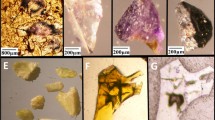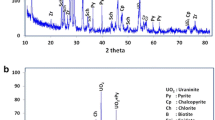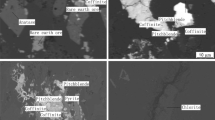Abstract
This paper discusses the leaching behavior of uranium from a low-grade unconformity-related uranium ore occurring in the northwestern part of the Kadapa basin in southern India. This is the major unconformity-related deposit located in India. The U3O8 assay of the ore is about 0.06%. The chief uranium-bearing phase is uraninite, and the ore also has a minor quantity of coffinite. The carbonaceous matter, as well as the porous titanium phases occurring in the ore, is also radioactive. The major gangue mineral is quartz, followed by minor quantities of sericite, chert, chlorite and feldspar. Detailed parametric variation studies were carried out on the ore to optimize conditions for sulfuric acid leaching of uranium values. Based on the laboratory results, preliminary design criteria were developed for process engineering. About 82% of uranium values were leached under conventional atmospheric leaching conditions. Uranium values present in the carbonaceous matter and the other refractory phases were solubilized only after roasting the leach residue. This process improved the overall leach recovery to about 89%.
Similar content being viewed by others
References
Bowell, R.J., Grogan, J., Hutton-Ashkenny, M., Brough, C., Penman, K. and Sapsford, D.J., 2011, “Geometallurgy of uranium deposits,” Minerals Engineering, Vol. 24, No.12, pp. 1305–1313.
Chaki, A., 2009, “An overview of uranium exploration strategy in India,” International Symposium on Uranium Raw Material for the Nuclear Fuel Cycle: Exploration, Mining, Production, Supply and Demand, Economics and Environmental Issues (URAM-2009), 15th Sep. 2009, IAEA, Vienna, Austria.
Edwards, C.R., and Oliver, J.A., 2000, “Uranium processing: A review of currents methods and technologies,” Journal of Metals, Vol. 52, No. 9, pp. 12–20.
Gasparrini, C. and Williamson, R.G., 1981, “The mineralogy of uranium ores with some consideration of their significance in metal extraction and mineral exploration,” Symposium on Process Mineralogy, 110th AIME Annual Meeting, Chicago, pp.325–337.
Gupta, R., and Sarangi, A.K., 2011, “Overview of Indian uranium production scenario in coming decades,” Energy Procedia, Vol 7, pp.146–152.
Habashi, F., 1980, Principles of Extractive Metallurgy, Vol. 1, Gordon and Breach, New York, pp. 223–251.
International Atomic Energy Agency, 2009, World Distribution of Uranium Deposits (UDEPO) with Uranium Deposit Classification, IAEA TECDOC 1629, International Atomic Energy Agency, Vienna, Austria, p.117.
Jefferson, C.W., Thomas, D.J., Gandhi, S.S., Ramaekers, P., Delaney, G., Brisbin, D., Cutts, C., Quirt, D., Portella, P., and Olson, R.A., 2007, “Unconformity associated uranium deposits of the Athabasca Basin, Saskatchewan and Alberta,” Mineral Deposits of Canada: A Synthesis of Major Deposit-Types, District Metallogeny, The Evolution of Geological Provinces, and Exploration Methods: Geological Association of Canada, W.D. Goodfellow, ed., Mineral Deposits Division, Special Publication, No 5, pp. 273–305.
Konka, U., Achar, K.K., Maithani, P.B., 2009, “Proterozoic unconformity related uranium mineralization in the Srisailam and Palnad Sub-Basins of Cuddapah Basin, Andhra Pradesh, India,” International Symposium on Uranium Raw Material for the Nuclear Fuel Cycle: Exploration, Mining, Production, Supply and Demand, Economics and Environmental Issues (URAM-2009), 15th Sep. 2009, IAEA, Vienna, Austria, 93 pp.
Levenspiel, O., 1972, Chemical Reaction Engineering, 2nd ed., John Wiley and Sons, Inc., New York, NY.
Lottering, M.J., Lorenzen, L., Phala, N.S., Smit, J.S., and Schalkwyk, G.A.C., 2008, “Mineralogy and uranium leaching response of low grade South African ores,” Minerals Engineering, Vol. 21, pp. 16–22.
Macnaughton, S.J., Ring, R.J., Day, A., Collier, D.E. and Tan, K.P., 1999, “Optimization of the leach conditions for a copper / uranium ore,” Proceedings of Sessions and Symposia sponsored by the Extraction and Processing Division of The Minerals, Metals and Materials Society, B. Mishra, ed., pp. 509–522.
Maley, M.J., Burling, S. and Ring, R., 2010, “The effect of oxidation — reduction potential and ferric iron concentration on leaching of uranium ores,” Proceedings of the 3rd International Conference on Uranium, E.K. Lam, J.W. Rowson, and E. Ozberk, eds., 40th Annual Hydrometallurgy Meeting, Saskatoon, Saskatchewan, Canada, Vol. 1, pp. 563–574.
Merrit, R.C., 1971, The Extractive Metallurgy of Uranium, Colorado School of Mines Research Institute, Golden Colorado, United States Atomic Energy Commission, Colorado, pp. 50–112.
Ram, R., Charalambous, F., Tardio, J. and Bhargava, S.K., 2011, “An investigation on the effect of Fe (FeIII, FeII) and oxidation reduction potential on the dissolution of synthetic uraninite (UO2),” Hydrometallurgy, Vol. 109, pp. 125–130.
Ring, R.J., 1980, “Ferric sulfate leaching of some Australian uranium ores,” Hydrometallurgy, Vol. 6, pp. 89–101.
Sinha, R.M., Parthasarathy, T.N. and Dwivedy, K.K., 1994, “On the possibility of identifying low cost, medium grade uranium deposits close to the Proterozoic unconformity in Cuddapah Basin, Andhra Pradesh, India,” Proceedings of a Technical Committee Meeting on Innovations in uranium Exploration, Mining and Processing Techniques, and New Exploration Target Areas, Vienna, December 1994, IAEA-TECDOC-868, pp. 35–55.
Verma, M.B, Maithani, P.B., Chaki, A., Nageshwar, Rao P., and Prakher Kumar, 2009, “Srisailam sub basin, an uranium province of unconformity-related deposits in Andhra Pradesh — case study of Chitrial uranium exploration, Nalgonda District,” Current Science, Vol. 96, No. 4 (25), pp. 588–591.
Author information
Authors and Affiliations
Corresponding author
Additional information
Paper number MMP-11-036.
Discussion of this peer-reviewed and approved paper is invited and must be submitted to SME Publications Dept. prior to February 28, 2013.
Rights and permissions
About this article
Cite this article
Sreenivas, T., Padmanabhan, N.P.H. Acid leaching of uranium from a low-grade Indian uranium ore deposit. Mining, Metallurgy & Exploration 29, 165–168 (2012). https://doi.org/10.1007/BF03402255
Received:
Accepted:
Published:
Issue Date:
DOI: https://doi.org/10.1007/BF03402255




